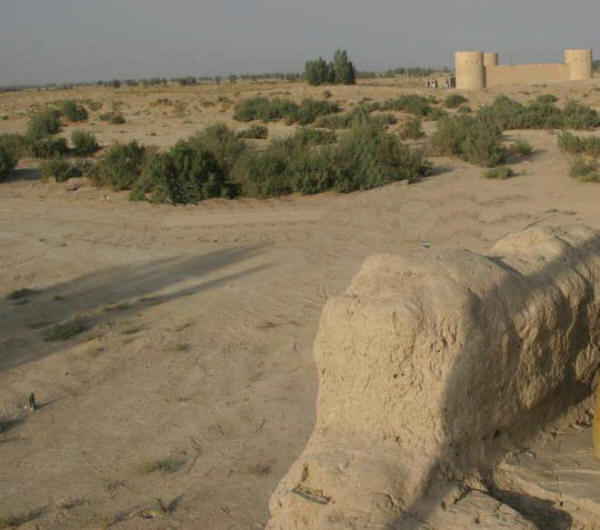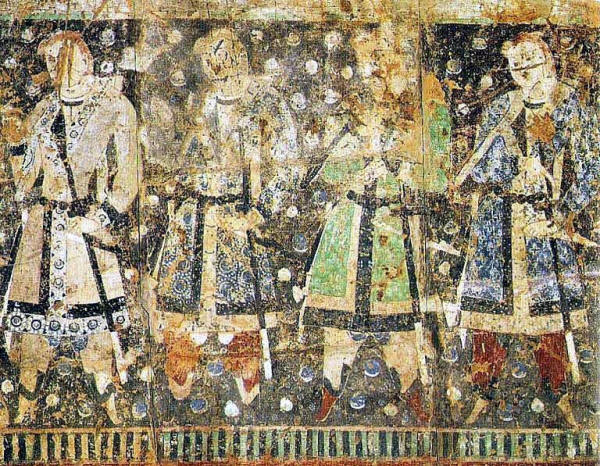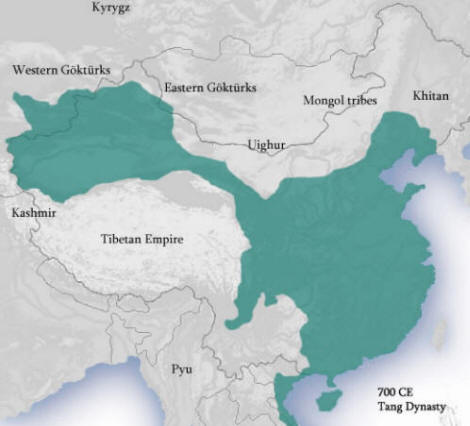
| END OF ZOROASTRIAN RULE IN IRAN End
of Zoroastrian Rule of Iran :
In 636 CE, the Arab engaged and defeated the Persian army in the battle of Qadisiyyah (now in South-Central Iraq). This event brought to an end Zoroastrian rule west of the Zagros mountains in Iranian Iraq. Next, in 642, the Arab armies crossed the Zagros mountains and invaded the Iranian plateau, the heartland of Iran, and defeated the Persian armies in the battle of Nahavand (near Hamadan). By 649 CE, Zoroastrian rule in Iran / Persia had effectively come to an end.
The last Zoroastrian dynasty to rule Iranian was the Sassanian dynasty (c.224 - c.649 CE) and the last of that dynasty's king was Yezdegird III (r. 633-649 CE).
Last Stands & Flight from Iran
Kaikhusrou, a younger member of the Sassanian royal family together with a number of other family members and other followers, fled to Sistan, the legendary home of Sam, Zal and Rustam.
In an Arabic book Futuh-ul-Buldan by Ahmad Ibn Yahya Ibn Jabir Al Biladuri, a ninth century CE writer who died c 892, the author tell us about Zoroastrians who took a stand against the advancing Arabs at Hormuz on the southern Iranian coast. The Zoroastrians were over-powered and fled by sea to Makran, the coast of Baluchistan to the east of Hormuz. The text reads :
"He (Mujasa bin Masood) conquered Jeraft (Jiroft, Kerman) and having proceeded to Kerman (city), subjugated the city and made for Kafs (Hormozgan) where a number of Persians, who had emigrated, opposed him by at Hormuz (the port of Kerman). So he fought with and gained victory over them and many people of Kerman fled away by sea. Some of them joined the Persians at Makran and some went to Sagistan (Sistan)." (cf. Translation from the Arabic by Rustam Meheraban Aga as quoted in an article The Kissah-e-Sanjan by Dr. Jivanji Modi in the Journal of the Iranian Association Vol. VII, No. 3. June 1918.)
When the Arabs under Al-Rabi bin Ziyad had crossed the desert between Kerman and Sistan-Baluchistan, they attacked a district called Zalik, overcame determined resistance and plundered it's city on the feast of Mehergan.
Then they advanced towards Zarang (called Zaranj by the Arabs, a city that is now the capital of Afghanistan's south-eastern Nimruz province that is turn was part of old Sistan).
Zaranj / zarang border area with Iran On the way the set upon the village of Rught whose inhabitants came out and fought a great battle inflicting heavy losses on the Arabs. Rabi, however, regrouped his forces and eventually overpowered the defenders. Then Rabi attacked Shirwad killing a large numbers of people. Finally, Rabi turned his forces on Zarang whose inhabitants led by Aparviz (Parviz?), the marzban of Zarang, resisted the Arab armies fiercely until the eventually succumbed. The story goes that when the Arab commander summoned the marzban to discuss the terms of conquest, he sat on the corpse of a dead defender. The terms included 1,000 slaves each with a golden goblet. Even after their defeat, the inhabitant's of Zarang mounted an insurgency and Rabi had to stay on in Zarang. Two years after their defeat, the inhabitants of Zarang rose up in open revolt and drove out the Muslim garrison. The Arab governor of Kerman, sent out yet another Muslim force to regain Zarang for the second time. They succeeded in 661 and also captured Zabol, a major city in the north of Sistan. However, Arab control of Zarang would, as we shall see, be challenged again.
There is some further history of the Zoroastrian resistance to be gleamed from two Chinese histories known as the Old and New Book of Tang, as well as a purported diary written by Piruz's son Narseh / Narsieh (reported at CIAS is an article Pirooz in China by Henry Wong. The diary was written in formal and aristocratic old Chinese.
The Old Book of Tang was compiled by Liu Xu between 941 and 945 during the reign of Emperor Chudi. Xu's edition was revised during the Song Dynasty (960-1279) and the revision came to be known as New Book of Tang. The Tang Dynasty (618-907) ruled China during the time of the Arab invasion of Iran and the following critical centuries. The two books do differ on some key aspects of how and who in The Sassanian royal family the Chinese assisted in resisting the advance of the Arab armies.
According to The Old Book of the Tang, in around 661 CE, Yazdegird III's son Piruz / Pirooz / Peroz / Firooz / Pinyin (Chinese) appealed to the Chinese court for help resisting the Arabs.
According to Wong citing Narsieh's diary, upon the death of his father Yezdegird III, Piruz wrote a letter to his sister - who was the wife of the Chinese emperor - requesting Chinese assistance which was slow in coming. With the Arab armies in sight, Piruz could no longer wait. Together with other Persian nobility, their families and accompanying soldiers, they decided to cross the Pamirs and arrived in China in the 660s CE. In the Chinese capital, he found long-established Persian, Sogdian, and Bactrian merchant communities who had settled in China. Escorted into the Chinese emperor's presence, Piruz prostrated before the emperor who embraced him and kissed him on the cheeks. The emperor reassured Piruz saying, "You've come a long way. Have no more fears. For you are my brother and this is your new home." With tears in his eyes, Piruz knelt and thanked the emperor. The emperor permitted Piruz and the Persians to settle in 38 villages and rebuild their communities. They were also allowed to set up a royal court in exile.
Piruz learned Kung Fu (martial arts) and became a general in the emperor's court. The Chinese had by this time established garrisons (apparently financed by Piruz) in what is today Tajikistan, eastern Afghanistan and parts of Uzbekistan and these eastern Iranian-Aryan lands became part of China for a while and contained the Arab advance.
Returning to The Old Book of the Tang, the Chinese made Piruz Commander of the Western Flank and eventually assisted Piruz in resisting the Arabs by giving him a battalion with which Piruz liberated Zarang in Sistan from the Arabs. It is not without significance that the present population of Zarang (Zaranj) consists of 44% Balochis, 34% Pashtuns and 22% Tajiks. From Zarang, Piruz governed what remained of Iranian-Aryan lands thirty years till his death in 709.
Wong's tells us in his translation of the Narsieh diary, that when Piruz was ailing, with his entire exiled court and the Chinese emperor in attendance, he requested a simple funeral. His request made the ailing Piruz turned to the west and said, "I have done what I could for my homeland (Persia) and I have no regrets." Turning to the east he said, "I am grateful to China, my new homeland." Then he turned towards the Persians and said, "Contribute your talents and devote them to the emperor. We are now Chinese." With those words said, he passed from this life. At his funeral, a magnificent stallion was led to gallop around the regent's body 33 times - that being the number of his military victories over the Arabs. For Prince Piruz had spent the last years of his life fighting the Arab invaders of Aryan lands.
Piruz's son Narsieh married a princess of the Tang Imperial Family and his descendants adopted the Tang Imperial Family Name Li. Narsieh's daughters and sons all married into Chinese royalty and aristocracy as did all the Persian nobility exiled in China. And so ended the Sassanian Dynasty.
The Last Sassanian Resistor :
The fleeing Zoroastrians made their last stands against the Arabs in several places including Khorasan, Sistan and Hormuz. In these regions, insurrections and revolts against the Arabs continued for about a century. In these, their last stands, Persian patriots and Zoroastrians either died, were taken prisoner, finally submitted or fled further east into India and China. While their names are lost to history and they remain unknown, their spirit lives through these words. Aidun bad.
Source :
http://www.heritageinstitute.com/ |


